Angelfish are popular because of their long, flowy fins and beautiful colors.
Many aquarists don’t realize that angelfish grow quite large and have a bit of a temper. They are too aggressive for smaller tropical fish and too passive for cichlids.
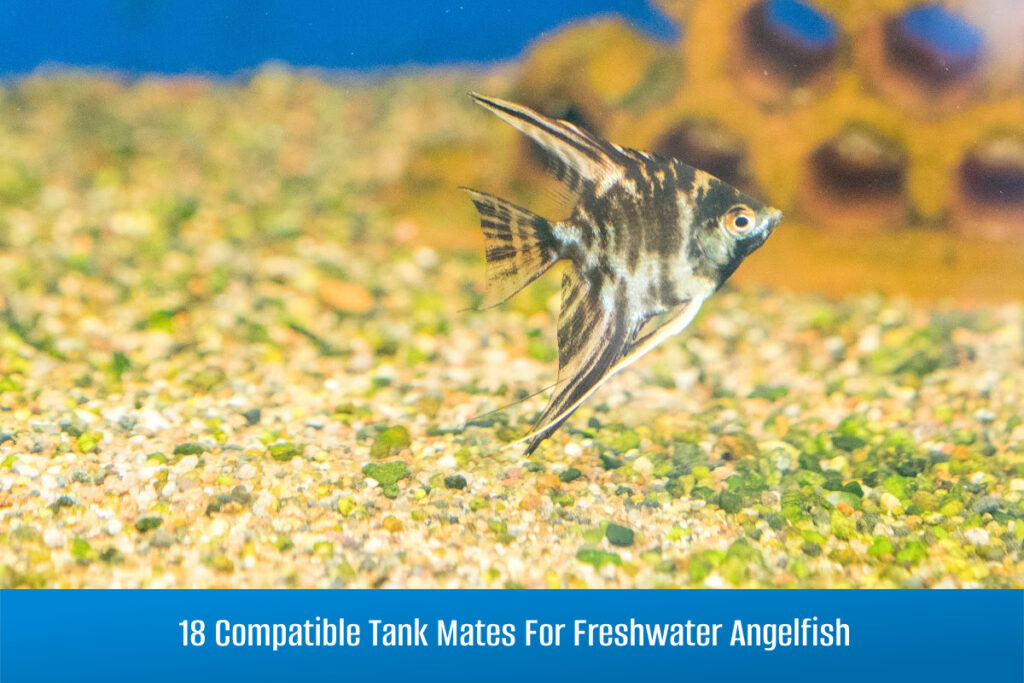
Choosing the right tank mates for freshwater angelfish requires a balance.
Though it can be tricky, plenty of fish do well with angelfish. Among them include some tetras, plecos, rainbowfish, and rams.
What Are Freshwater Angelfish?
Freshwater angelfish have stout, wide bodies with tall, peaked dorsal fins. The fins underneath their bodies are long and threadlike. They trail elegantly under their bodies.
Angelfish come in all different colors and patterns. They may be silver, albino, or platinum, amongst other colors. Patterns include marble, zebra, and leopard.
Angelfish are a type of cichlid that lives in South America across the Amazon River system. They inhabit murky, slow-moving waters with lots of vegetation.
There are three known species of freshwater angelfish:
- Pterophyllum scalare — commonly available in pet stores
- Pterophyllum leopoldi — rare in pet stores
- Pterophyllum altum
P. scalare, the species most aquarists own, can reach up to 6 in (15.2 cm) long. Their dorsal fins and tendrils mean that, vertically, angelfish can have a height of up to 8 in (20 cm).
Besides being large, angelfish have long lives and are long-term pets. Angelfish that receive the proper care may live for 8 to 12 years.
Angelfish Temperament
One of the most important things to keep in mind when choosing tank mates is the angelfish’s temperament. Generally, they are “semi-aggressive.”
These fish are mostly passive when they are not in the breeding season. They work with many community fish species of similar sizes.
Those feeling broody will chase and spar with one another to defend their territory. Parents are fiercely protective of their eggs and fry.
The Best Tank Mates For Angelfish
There are a lot of fish that make great tank mates for angelfish. Hobbyists must consider each fish’s care needs and temperament before choosing.
It’s always best to introduce tank mates while angelfish are still juveniles. Young angelfish are less likely to be aggressive or territorial.
Adding tank mates while angelfish are young gives them a chance to get to know each other. Once they grow into adults, they are less likely to harass their tank mates.
1. Corydoras Catfish (Corydoras sterbai)
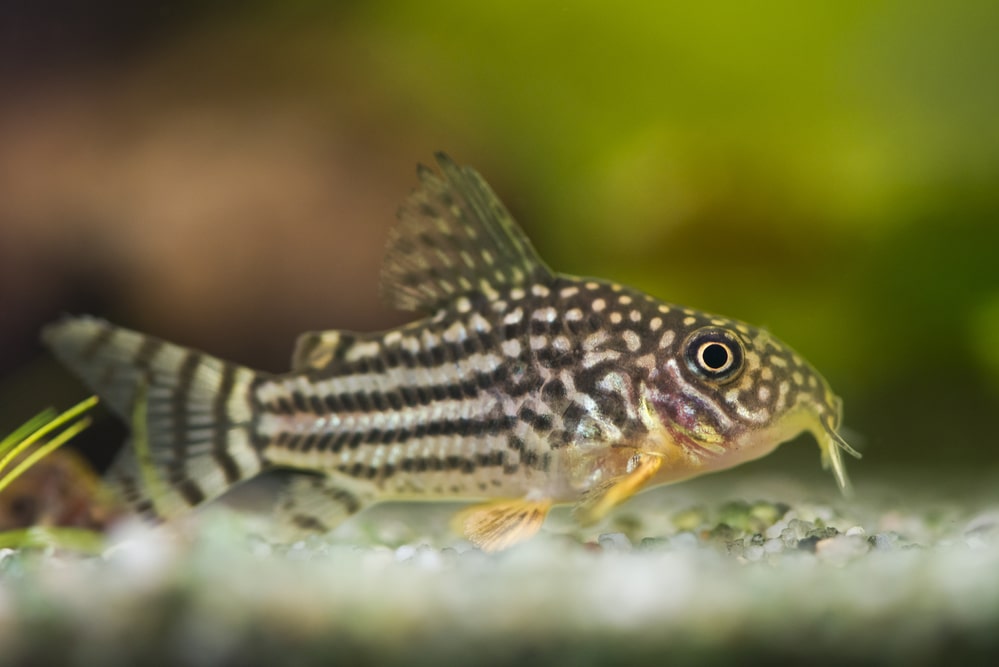
- Compatibility Rank: 10/10
- Care Level: Easy
- Size: 1-3 in (2.5-7.6 cm)
- Temperature Requirements: 72-82 °F (22.2-27.8°C)
- Temperament: Peaceful
Corydoras catfish are hardy, low-maintenance, bottom-dwelling fish.
Wild individuals live in South America; they have similar care needs to angelfish.
Cory cats are social animals who feel most comfortable in groups. Aquarists must buy at least three or four individuals; the more, the better.
They are shy fish with friendly personalities that won’t bother angelfish. Likewise, the angelfish will leave them alone since they swim in different parts of the tank.
As they are bottom dwellers, cory cats help to keep the tank clean. They will eat any leftover fish food that sinks to the substrate.
2. Bristlenose Pleco (Ancistrus cirrhosus)
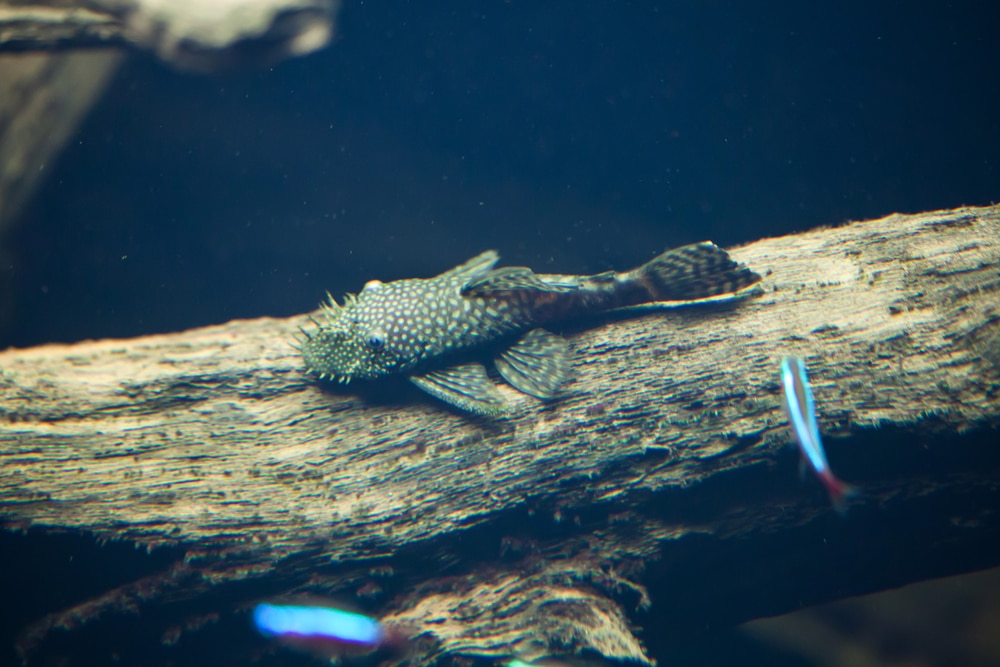
- Compatibility Rank: 10/10
- Care Level: Easy
- Size: 3-6 in (7.6-15.2 cm)
- Temperature Requirements: 60-80°F (15.6-26.7°C)
- Temperament: Peaceful
Bristlenose plecos are native to the Amazon River system, like angelfish. Their care requirements are nearly identical, making them ideal tank mates.
These plecos are hardy animals that are easy to care for. Provide them with some driftwood and plants to feed on, and they’ll be happy.
Like Corydoras, plecos are unassuming bottom dwellers. They are shy and stay out of the way of angelfish. Plecos prefer to spend most of their day hiding.
Many aquarists enjoy plecos because they help keep the tank clean. They feed on leftover food around the tank as well as some algae. They are so efficient at eating leftovers that hobbyists should only keep one per tank.
Unlike other plecostomus species, bristlenose plecos stay moderate in size. They won’t take up a bunch of space or create as much waste as their larger relatives.
3. Swordtails (Xiphophorus Hellerii)
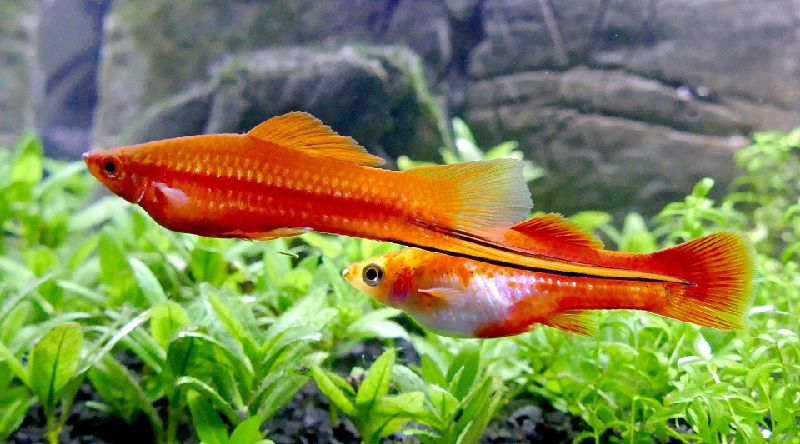
- Compatibility Rank: 10/10
- Care Level: Easy
- Size: Up to 6 in (15.2 cm)
- Temperature Requirements: 64-82 °F (17.8-27.8°CF)
- Temperament: Peaceful — can hold their own
Swordtails are colorful fish that grow to a moderate size. They are hardy and can withstand a wide range of water parameters.
They are popular among aquarists because of the various colors they come in.
The males have a uniquely long anal fin, which is where they get the name “swordtail.”
These fish are peaceful, though they aren’t afraid to defend themselves.
Aquarists must be cautious because swordtails are livebearers; they breed quickly and often. Since they are livebearers, the babies are born into the open water of the tank.Angelfish won’t hesitate to eat the baby swordtails.
Swordtail fry make a good snack. Eating them helps keep the swordtail populations down. Livebearers can quickly overpopulate a tank otherwise.
Still, some hobbyists don’t like the thought of angelfish eating their other fish. It’s a matter of preference.
4. Mollies (Poecilia reticulata)
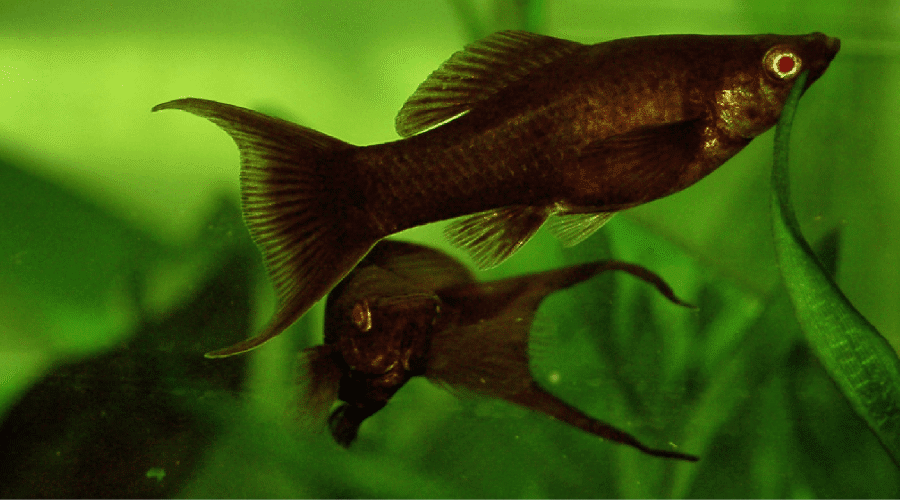
- Compatibility Rank: 10/10
- Care Level: Easy
- Size: Up to 5 in (12.7 cm)
- Temperature Requirements: 72-80°F (22.2-26.7°C)
- Temperament: Peaceful — can stand up for themselves
Mollies are one of the hardiest freshwater tropical fish available for aquariums. They can adapt to various water parameters, including brackish water.
Mollies are livebearers, like swordtails. They give birth to tiny live young that become snacks to angelfish. Move pregnant mollies to a different tank to prevent angelfish from eating them.
These fish are generally peaceful and get along well with most community fish. They are larger than the other livebearers and better at handling bullying.
Mollies come in all kinds of shapes and colors; hobbyists can have a variety of exciting fish.
5. Boesemani Rainbowfish (Melanotaenia boesemani)
- Compatibility Rank: 10/10
- Care Level: Easy
- Size: 4 in (10.2 cm)
- Temperature Requirements: 75-82°F (23.9-27.8°C)
- Temperament: Peaceful
Boesemani rainbowfish are beautiful animals with bright colors. As juveniles, they are a dull silver color. As adults, they develop a shiny blue on the front half of their body and bright orange on their back half.
These fish are peaceful and mostly ignore other species in their tank.They are social with members of their species and must live in groups of at least six.
Rainbowfish are very active and enjoy flitting about their tank.
The larger size of Boesemani rainbowfish means they can handle some bullying.
6. Praecox Rainbowfish (Melanotaenia praecox)
- Compatibility Rank: 10/10
- Care Level: Easy
- Size: Up to 3 in (7.6 cm)
- Temperature Requirements: 74-80°F (23.3-26.7°C)
- Temperament: Peaceful
Praecox rainbowfish are hardy fish that do well in most community aquariums.
These fish are colorful like Boesemani rainbowfish, though slightly smaller. They are still large enough to handle some bullying from angelfish.
As juveniles, they are a dull silver color. As adults, their entire body takes on an iridescent blue shine, while the fins are bright orange.
Praecox rainbowfish are peaceful schooling fish that must live in groups of six or more.
7. Keyhole Cichlids (Cleithracara maronii)
- Compatibility Rank: 10/10
- Care Level: Easy
- Size: 4-5 in (10.2-12.7 cm)
- Temperature Requirements: 72-80 °F (22.2-26.7°C)
- Temperament: Peaceful
Keyhole cichlids are hardy animals and one of the most peaceful cichlid species. Hobbyists enjoy these animals because of their friendly personalities.
They are unlikely to nip at angelfish or cause any problems.
Unfortunately, these fish can be somewhat tricky to find in pet stores.
8. Platies (Xiphophorus maculatus)
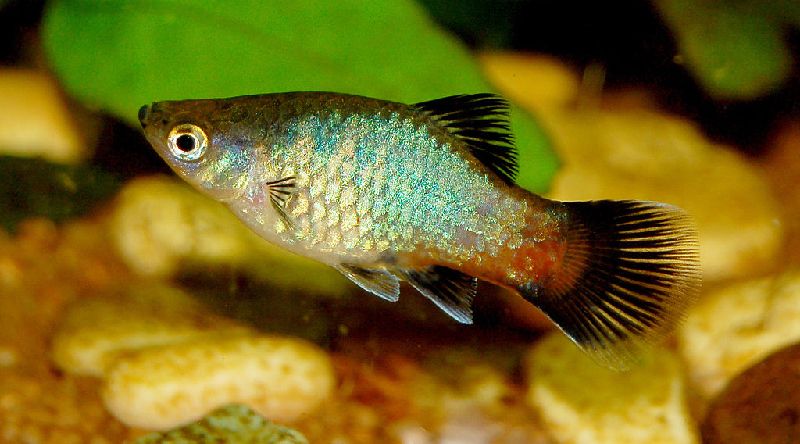
- Compatibility Rank: 9/10
- Care Level: Easy
- Size: 2.5 in (6.4 cm)
- Temperature Requirements: 70-82°F (21.1-27.8°C)
- Temperament: Peaceful
Platies are staples in community tanks because they’re colorful, peaceful, and energetic. They are a hardy species that can tolerate a wide range of water parameters.
Like swordtails, platies are livebearers that give birth to young in the water column. Hobbyists must decide if they are okay with their angelfish eating the babies.
Aquarists can always move the mother to another tank when she becomes pregnant. Raise the babies in a separate tank until they are large enough to move into the main tank with the angelfish.
9. German Blue Ram Cichlids (Mikrogeophaus ramirezi)
- Compatibility Rank: 9/10
- Care Level: Moderately Difficult
- Size: 2-2.5 in (5.1-6.4 cm)
- Temperature Requirements: 84-86°F (29-30°C)
- Temperament: Relatively peaceful
German blue rams are some of the most colorful and peaceful cichlids aquarists can own. They have similar temperaments as angelfish, making them ideal tank mates.
Plus, since both species are cichlids, they have similar care requirements.
Rams spend most of their time in the bottom to middle layers of the tank. They rarely interact with angelfish who stay near the top of the tank.
Unfortunately, rams are challenging to care for. They aren’t a good fit for inexperienced hobbyists.
Rams need pristine water quality and are extremely sensitive to toxins. Testing the water and cleaning the tank regularly is a must.
10. Kuhli Loach (Pangio kuhlii)
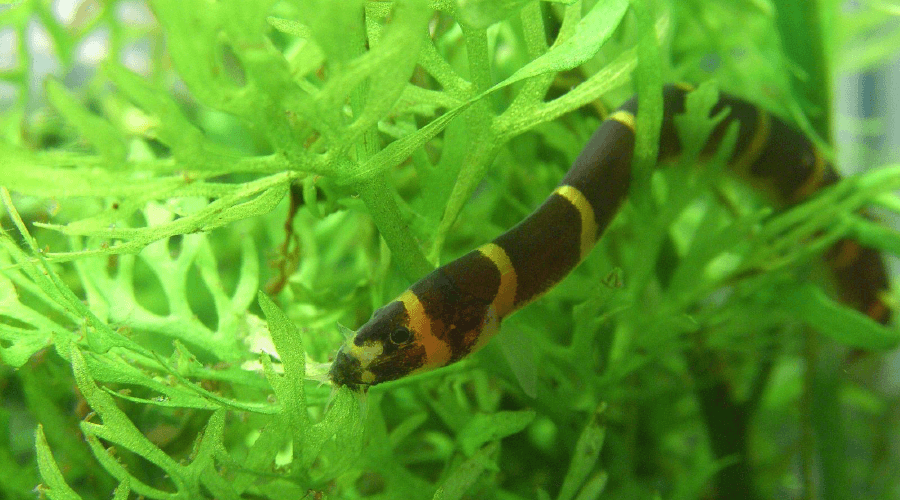
- Compatibility Rank: 9/10
- Care Level: Easy
- Size: 3-5 in (7.6-12.7 cm)
- Temperature Requirements: 74-80°F (23.3-26.7°C)
- Temperament: Peaceful
Kuhli loaches are interesting fish that look like eels and snakes. They have long, thin bodies that they use to hide inside crevices.
Kuhli loaches are bottom-dwellers that stay out of the way of angelfish. They are peaceful fish that do excellently in community tanks.
Make sure to have at least three to four loaches. They are social animals that become timid when kept alone.
Hobbyists rarely see their Kuhli loaches because they are masters of hiding. Kuhli loaches are nocturnal; they are most active at night. They prefer to hide underneath rocks and inside decorations during the day.
Kuhli loaches help keep snail populations under control. Snails are one of their favorite foods.
11. Zebra Loaches (Botia striata)
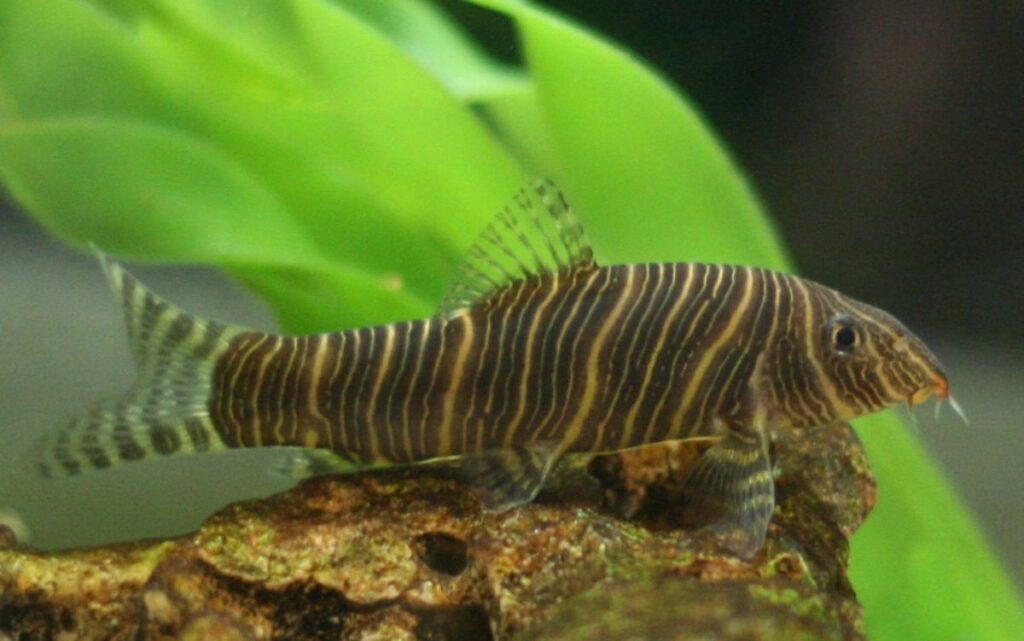
- Compatibility Rank: 9/10
- Care Level: Easy
- Size: 3-4 in (7.6-10.2 cm)
- Temperature Requirements: 73-79°F (22.8-26.1°C)
- Temperament: Semi-aggressive
Like Kuhli loaches, zebra loaches are bottom dwellers who spend much time hiding.
Zebra loaches are semi-aggressive. Often, their personalities are too feisty for many community tanks. Yet, their personalities make them perfect tank mates for angelfish. They can give the angelfish’s attitude right back to them.
Still, as bottom dwellers, they rarely interact with the angelfish at all.
Zebra loaches are social with members of their species and must live in schools of five or more.
Like other bottom dwellers, zebra loaches help keep the tank clean. They happily eat whatever leftover fish food sinks to the substrate.
12. Dwarf Gourami (Trichogaster lalius)
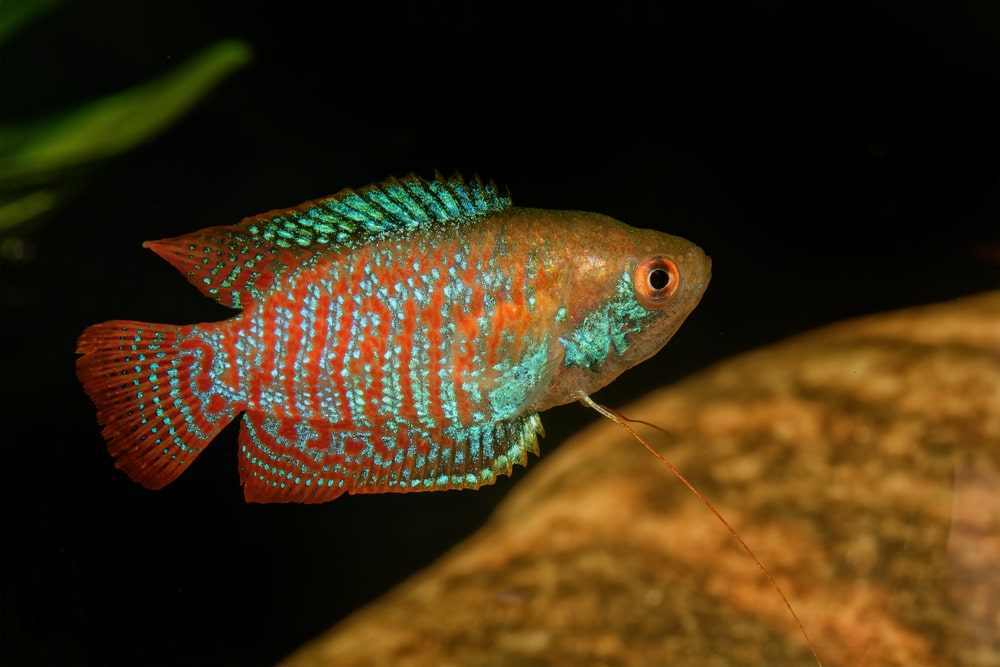
- Compatibility Rank: 8/10
- Care Level: Moderate
- Size: 3-5 in (7.6-12.7 cm)
- Temperature Requirements: 72-82 °F (22.2-27.8°C)
- Temperament: Peaceful
Dwarf gouramis are generally shy and do not cause problems. Provide them with many caves, rocks, and plants to hide in to feel secure.
Males may become territorial with other males, especially during breeding time. Aquarists should have at most one male gourami per tank.
Keep one male to several females, and they will do well.
Their docile nature can sometimes cause problems with angelfish. Angelfish may become territorial and bully gouramis.
The gouramis are typically so passive that they won’t defend themselves. Hobbyists should have another tank to move their gouramis into if needed.
13. Head & Tail-Light Tetras (Hemigrammus ocellifer)
- Compatibility Rank: 8/10
- Care Level: Easy
- Size: 2 in (5.1 cm)
- Temperature Requirements: 72-79°F (22.2-26.1°C)
- Temperament: Peaceful — may nip at fins
Head and tail light tetras are native to the Amazon River system. They have similar needs as angelfish. They are also hardy animals that can handle a wide range of water parameters.
These tetras are schooling fish and should live in groups of at least six.
The more tetras living together, the happier the animals will be. They display their schooling behavior better in large groups and feel safer.
All tetras are prone to some fin-nipping. Such behavior is most common when their schools need to be bigger or when there is overcrowding.
Still, head and tail light tetras are among the most peaceful tetra species. They are less likely to nip at fins than others.
14. Lemon Tetras (Hyphessobrycon pulchripinnis)
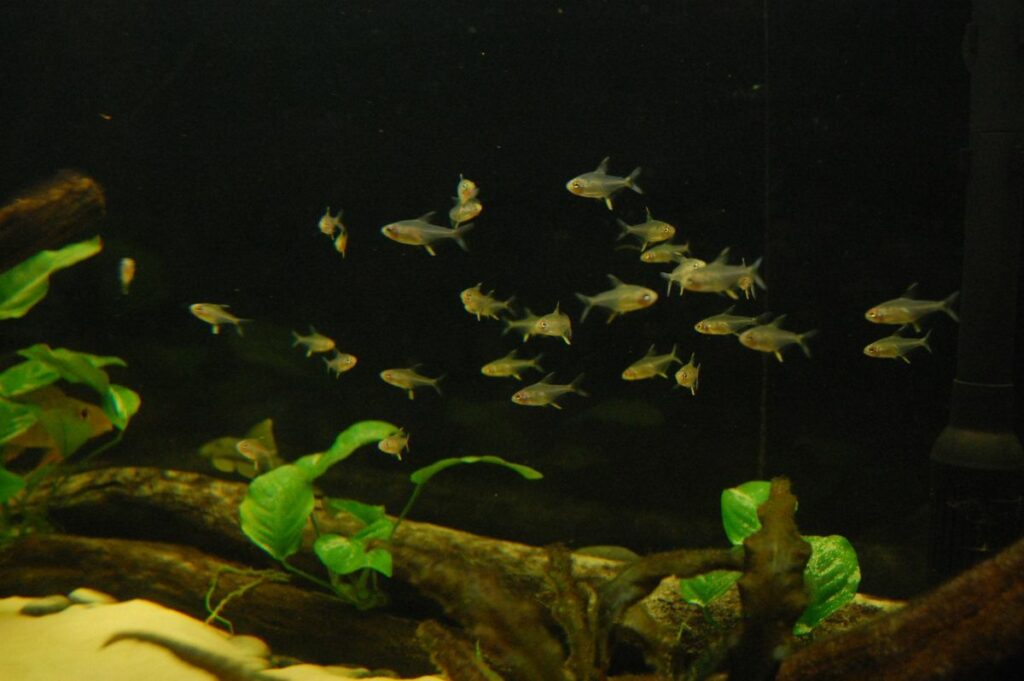
- Compatibility Rank: 7/10
- Care Level: Easy
- Size: 2 in (5.1 cm)
- Temperature Requirements: 72-82°F (22.2-27.8°C)
- Temperament: Peaceful — may nip at fins
Lemon tetras are native to the Amazon River system, like angelfish. They have similar care requirements, making them good tank mates.
These fish are hardy animals that can tolerate various water parameters.
Lemon tetras are peaceful and do well in community tanks. They are somewhat smaller than angelfish; watch for potential bullying. Conversely, watch for fin-nipping from the tetras.
Only add adult lemon tetras to the tank; angelfish will likely eat juveniles.
Lemon tetras are social schooling fish that must live in groups of at least six.
15. Rummy Nose Tetras (Hemigrammus bleheri)
- Compatibility Rank: 7/10
- Care Level: Easy
- Size: 2 in (5.1 cm)
- Temperate Requirements: 72-82°F (22.2-27.8°C)
- Temperament: Peaceful — may nip at fins
Rummy nose tetras are small, peaceful, schooling fish. They are hardy animals that can tolerate a wide range of water parameters.
Like the other tetras, they are schooling fish and must live in groups of at least six.
Watch for aggression from the angelfish, and only add adult tetras to the tank. Their small size makes them susceptible to bullying from angelfish. Juveniles are likely to become a snack.
16. Guppies (Poecilia reticulata)
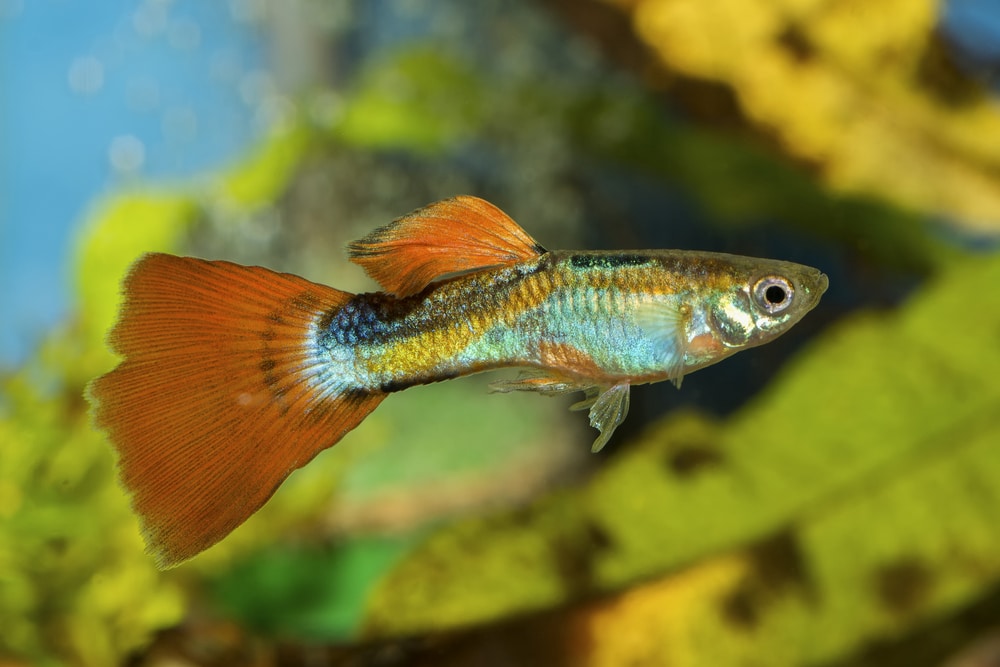
- Compatibility Rank: 7/10
- Care Level: Easy
- Size: 2 in (5.1 cm)
- Temperature Requirements: 72-82°F (22.2-27.8°C)
- Temperament: Peaceful
Guppies are generally easy to keep. Yet, they tend to be more sensitive to water quality than other fish, like tetras.
Like platies, swordtails, and mollies, guppies are livebearers. They give birth to tiny, live babies that will become a snack to any angelfish in the tank. Aquarists should move pregnant guppies to a separate tank if they want the babies to live.
The downside to guppies is that they are small and make easy prey for angelfish.
Start the tank with adult guppies and juvenile angelfish. Getting the angelfish while they are young teaches them that the guppies are tank mates — not food.
As with tetras, keep an eye on the guppies in case they are experiencing bullying from the angelfish. Prepare to move the guppies to a separate tank if the angelfish show too much aggression.
17. Kribensis Cichlids (Pelvicachromis pulcher)
- Compatibility Rank: 6/10
- Care Level: Moderate
- Size: 3-4 In (7.6-10.2 cm)
- Temperature Requirements: 75-80°F (23.9-26.7°C)
- Temperament: Semi-aggressive
Kribensis cichlids are colorful fish with loud, feisty personalities. They are semi-aggressive fish with similar personalities to angelfish.
Like angelfish, Kribs tend to be most aggressive during breeding time. Still, they aren’t afraid to give an attitude at other times.
Kribs prefer to swim in the middle to lower levels of the aquarium. Angelfish prefer to stay closer to the top. The two species are unlikely to interact much, and there shouldn’t be much fighting.
Forego the smaller fish on this list when housing Kribs and angelfish together. They may gang up on the smaller, more peaceful fish and cause problems.
Of all the species on this list, Kribensis is the most aggressive. Hobbyists looking for a true “community” tank will likely want to skip this species.
To reduce their aggression, provide Kribs with plenty of caves to hide in. They will claim the caves as their own and defend their territory. Having a shelter to protect generally makes them less aggressive.
18. Zebra Danios (Danio rerio)
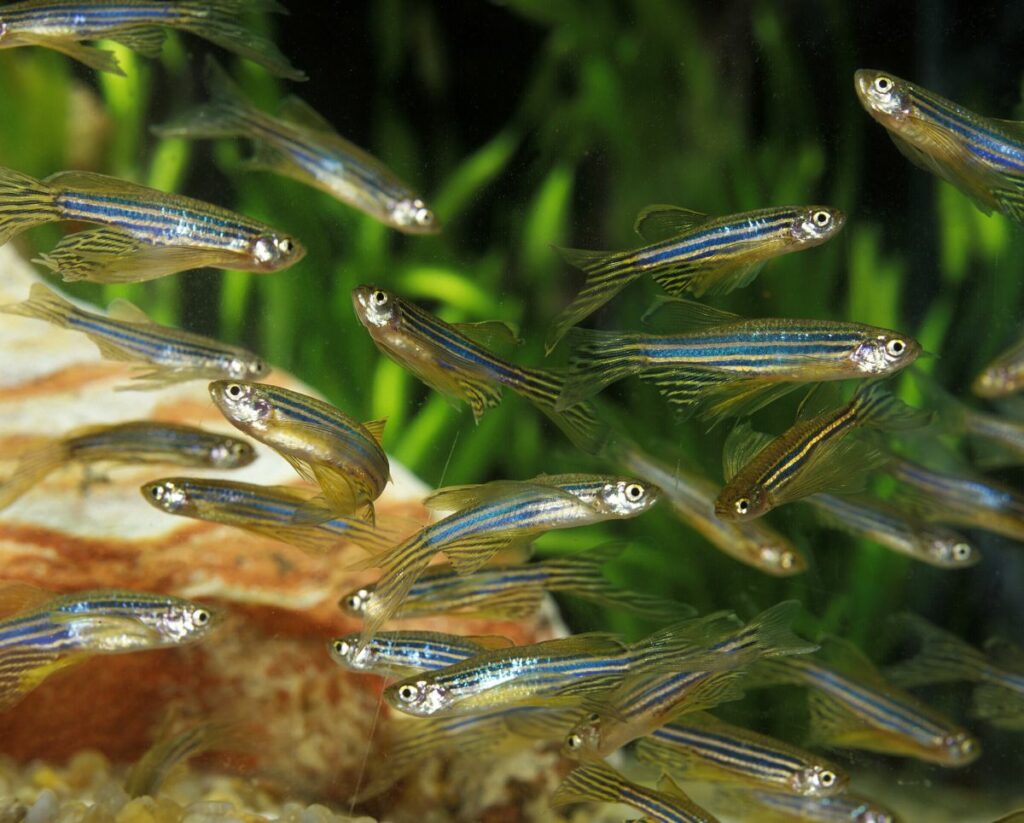
- Compatibility Rank: 6/10
- Care Level: Easy
- Size: 1.5 in (3.8 cm)
- Temperature Requirements: 64-75°F (17.8-23.9°C)
- Temperament: Peaceful
Zebra danios are trendy community freshwater fish. They are popular because of their dynamic behavior and fun patterns. They are one of the best fish for beginners. Zebra danios are incredibly hardy; almost nothing can kill them.
Zebra danios are small fish that would usually be incompatible with angelfish.
Yet, danios are swift swimmers that usually have no trouble escaping hungry angelfish.
They are schooling fish that need to live in groups of at least six. Their schooling behavior helps protect them from angelfish.
Danios are top dwellers. They will come into contact with the angelfish more often than the other species on this list.
Aquarists should keep an eye on how the two species interact with one another. Have another tank set up and ready in case one species needs moving.
What Tank Requirements Do Angelfish Need?
Aquarists must ensure all tank mates can tolerate the same water parameters. It’s cruel to house fish in an aquarium that doesn’t suit their needs.
For example, goldfish and angelfish cannot live together. Goldfish are a cold-water species, while angelfish are a tropical species. Turning the temperature up would cause the goldfish to suffer and vice versa.
These are the basic care requirements of freshwater angelfish:
- Tank Size: 55+ gallons (up to 4 angelfish & some tank mates)
- Water Temperature: 78-86°F (25.6-30°C)
- pH: 6.0-8.0
- Carbonate Hardness: 3-8 dKH
- Ammonia: 0 ppm
- Nitrites: 0 ppm
- Nitrates: >40 ppm
What Animals Should You Avoid?
Angelfish are generally peaceful when they are not breeding. Still, they won’t hesitate to eat small fish; aquarists should avoid fish small enough to fit in their mouths.
Avoid large, aggressive species of cichlids that will attack or eat the angelfish.
Angelfish have delicate, stringy fins that easily experience damage. Avoid fin nippers that will go after them. Fin nippers include barbs and most tetras. The tetras included on this list are generally very peaceful. They rarely nip at fins, though the possibility remains.
FAQs
Are Angelfish Schooling Fish?
Angelfish are not technically schooling fish. Still, they are social animals that enjoy being in groups.
“Schooling” is a specific behavior in which a group of fish swims together in the same direction. Their movements match each other so that they move simultaneously.
Angelfish swim together in groups but don’t display this synchronized behavior.
Are Angelfish Hard To Keep?
Angelfish are easy to keep once hobbyists get their tanks set up correctly. They are reasonably hardy animals with typical water requirements.
They may be a challenge for those new to the aquarium hobby.
Angelfish are best for those with intermediate aquarium experience. Yet, beginners who do a lot of research before buying angelfish should have success.

Helpful comments..I have 2 tanks; side-by-side; 15 gal and 30 gal. Each has a large male Angel. The two males are great rivals and posture and give stink-eye to each other through the glass. No charging or bumping into the glass. Each tank has several corys and the larger tank has a big fat Goldfish as well as a smaller female Angel, good company all around. The Angels are around 2 & 1/2 – 3 years old and I was hoping to add some company for the Black Lace boy.
Nice website; colorful and highly informative. Will probably try some Platies or Rummy Nose Tetras. The Angel is quite large and pretty gassed up. The 15 gal column tank has good hidey-holes and plants so should be ok to introduce some neighbors.
Wish us luck and thanks for your thoughtful tips.
Regards,
Kristina, aka, Mother-Of-Too-Many-Dogs-Chickens-And-Fish
Goldfish can’t be with angels, since they prefer 75 or lower, and angels prefer 78 -82 Farenheit
Can all these fish be in the same tank ? With or without a angelfish
Are catfish compatible with (big) angel fish
Can I have a few angel fish with my guppies and tetras ?
thank you. Im going to try some small angels with my guppies.
Is frontosa ciclids are ok to be a tank mate of angel fish?